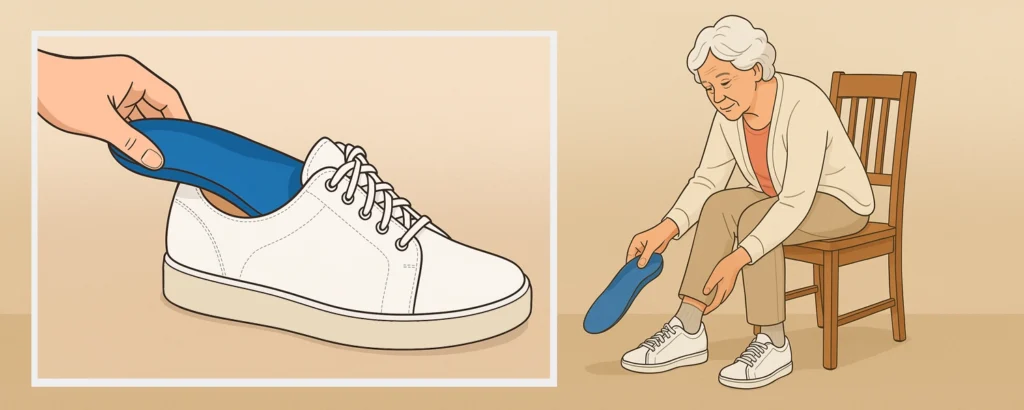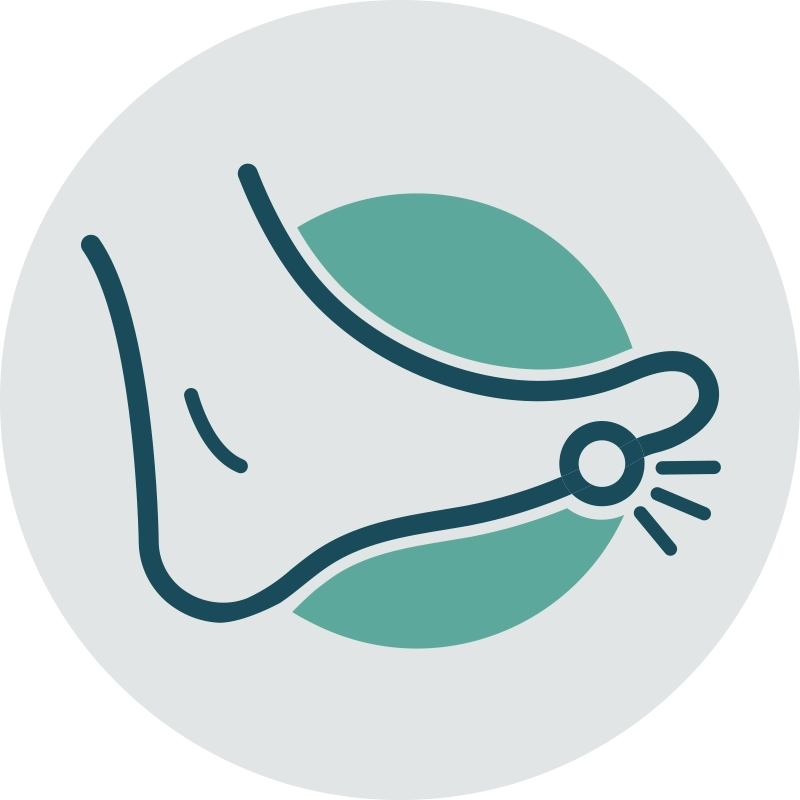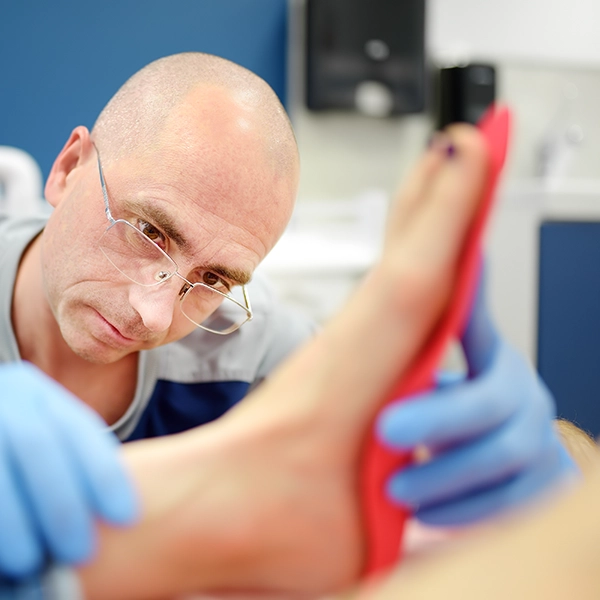All About Orthotics

Orthotics are not shoe inserts—they’re a medical device that is custom made for each individual and a proactive step toward better foot health, especially for seniors.
As we age, our feet undergo changes that can affect balance, mobility, and overall well-being. Custom orthotics, designed by your Upperline Podiatrist, offer tailored support to address these issues.
The Financial Impact of Improper Footwear
Wearing ill-fitting shoes isn’t just uncomfortable—it can lead to significant health issues and financial costs, particularly for older adults.
- Increased Risk of Falls: A study highlighted that improper footwear is a common cause of falls among those over 65, leading to injuries that require medical attention.1
- Medical Expenses: Falls and foot-related issues contribute substantially to healthcare costs. For instance, falls account for 85% of seniors’ injury-related hospitalizations in Canada.2
Investing in proper footwear and orthotics can mitigate these risks, leading to better health outcomes, reduced medical expenses and lead to an increase in quality of life.
Top 5 Benefits of Using Custom Orthotics
- Enhanced Balance and Stability: Orthotics provide support and help maintain proper posture, balance and reduce the risk of falls.3
- Pain Relief: Custom orthotics help with the pain associated with conditions like plantar fasciitis, arthritis, and general foot fatigue.
- Improved Mobility: By correcting and maintaining proper foot alignment, orthotics can enhance walking efficiency and reduce strain on joints.
- Prevention of Foot Deformities: Consistent use of your custom orthotics can help to slow and even prevent issues like bunions or hammertoes.
- Support for Daily Activities: Whether standing for long periods or engaging in physical activity, orthotics provide the necessary support to stay active.
How Orthotics Help with Specific Foot Conditions
Let’s take a closer look at how custom orthotics made by your Upperline Podiatrist help manage six common foot issues:

1. Hammertoe
Hammertoes result when there is contracture to any of the joints in the toes. This can be painful, especially when wearing shoes, and it may worsen over time.
Orthotics help redistribute pressure across the foot, relieving strain on the affected toes. Podiatrist can design orthotics with various custom modifications such as a metatarsal pad or toe crest to support the proper alignment of the toes and prevent rubbing against the top of shoes, which often causes painful corns or blisters.
By reducing friction and pressure, orthotics can make walking more comfortable and may help slow progression of Hammertoes if addressed early.
2. Bunions
Bunions, commonly thought of as a “bump” on the side of the foot, are caused by malalignment of the bones of the foot. They often caused or worsened by improper foot mechanics and narrow footwear.
Custom orthotics relieve pressure on the bunion, promote better alignment of the toes, and correct the faulty gait mechanics that contribute to worsening of the bunion deformity. By supporting the arch and adjusting foot position, orthotics reduce the forces that push the big toe outward.
While orthotics won’t eliminate a bunion, they can significantly reduce pain and delay or even prevent the need for surgical correction.
3. Plantar Fasciitis
One of the most common causes of heel pain, plantar fasciitis is the inflammation of the thick band of tissue (the plantar fascia) that runs across the bottom of your foot.
Orthotics help by offloading pressure from the heel and supporting the arch, which reduces tension on the plantar fascia. Our UL Podiatrist can custom fabricate an orthotic with various modifications such as cushioning to the heel, designing a heel cup custom to the shape your own foot that promotes a smoother gait and avoids repetitive strain.
People with plantar fasciitis often find tremendous relief once they start using custom orthotics consistently—and even more so when combined with other treatment protocols prescribed by their Podiatrist.
4. Arthritis
Arthritis in the feet, especially osteoarthritis and rheumatoid arthritis, can lead to joint pain, stiffness, and swelling that severely impact a patient’s mobility and quality of life.
Custom orthotics for arthritic feet are designed to off-load the joints, reduce shock during walking, and promote even weight distribution to minimize pressure points.
Your Podiatrist may also include features like extra depth, rocker soles, or soft accommodations to compensate for joint deformities and pain. A well-designed custom orthotic can greatly relieve Arthritic pain, improving your ability to remain active and independent with a higher quality of life.
5. Flat Feet
Flat feet (also called fallen arches) can be the result of overpronation—when the ankle rolls inward during each step. This can create stress on the ankles, knees, hips, and even the lower back because our body is a biomechanical chain.
Orthotics provide custom arch support that helps to realign the effected joints, promoting a more neutral gait. This not only alleviates foot pain but also helps prevent secondary issues like shin splints and knee pain as well as pain in other joints.
Without proper support, flat feet can worsen over time, leading to joint stress and muscular imbalances. Early intervention with orthotics can have long-term benefits for posture, movement and can help prevent surgery later in life.
6. Shin Splints
Often caused by repetitive stress and/or poor foot biomechanics, shin splints result in pain to the lower leg decreasing quality of lift and causing many people to avoid activity all together.
Podiatrists address shin splints with custom orthotics that correct the cause of the Shin Splint and absorb shock thereby reducing the impact of each step. This is particularly helpful for runners, people with high activity levels, or those whose jobs require prolonged standing or walking.
Over time, orthotics can help not just with symptom relief but can help prevent recurrence by correcting biomechanical faults.
How Our Upperline Podiatrists Design Custom Orthotics for You

An Upperline podiatrist goes through a comprehensive evaluation process to create orthotics that match your feet and condition precisely. Here’s what that typically involves for our patients:
1. Physical Exam & Medical History
Your Podiatrist will perform a full bio-mechanical exam with muscle testing and ask questions about your lifestyle, activity level, and any existing medical issues.
2. Gait Analysis
Our Podiatrist will perform a full Gait Analysis by watching your walk. By analyzing your gait your Upperline Podiatrist can identify biomechanical issues such as overpronation, over supination and any other issues that may negatively impact your quality of life.
3. 3D Scan or Mold
Your Upperline Health Podiatrist may take a digital scan, foam box impression, or plaster mold of your feet. This ensures that the orthotic matches your exact contours and pressure points.
4. Customized Fabrication
Your orthotics are made using medical-grade materials matching your specific needs—whether that’s cushioning for arthritis, firm control for flat feet, or pressure redistribution for bunions or hammertoes.
5. Fitting and Adjustments
Once the orthotics are made, your Upperline Podiatrist will size the devies for your shoes ensuring comfort and a proper fit. Follow-up visits may be scheduled to make adjustments as your body adapts to your new custom devices.
This hands-on, personalized process ensures your custom orthotics work as a true medical device—not just a temporary fix.
The Dangers of Delaying Custom Orthotic Intervention
Don’t delay! Postponing the use of custom orthotics can lead to worsening foot problems, increased pain, and a higher risk of falls. Early intervention is crucial to maintaining mobility and preventing complications that could lead to more invasive treatments or surgeries at a later date.
Delaying care might not seem like a big deal at first. Maybe your feet are “just sore” or your arches ache only after long walks. But here’s the reality: foot pain is often the first sign of deeper issues and ignoring it can lead to a cascading of problems:
- Untreated plantar fasciitis can lead to chronic heel pain that limits activity.
- Flat feet can throw off your posture, contributing to knee, hip, and back problems.
- Joint issues caused by arthritis may worsen, limiting mobility permanently.
What starts as manageable discomfort can eventually require invasive treatments like steroid injections, physical therapy, or even surgery. If foot pain impacts your ability to stay active, that can impact everything from heart health to mental well-being.
By getting custom orthotics early, you can prevent complications, maintain independence and maintain your quality of life.
Take the First Step!
Custom Orthotics aren’t one-size-fits-all—and they shouldn’t be. With the help of your Upperline Health Podiatrist, you can get custom orthotics that address your specific condition, relieve pain, improve balance, and help you stay active.
Whether you’re dealing with plantar fasciitis, arthritis, flat feet, bunions, or any of the various conditions impacting the feet, custom orthotics should be one of the first things you consider when it comes to helping you live comfortably, confidently and maintaining your quality of life.
If your feet are trying to tell you something, don’t wait. Talk to an Upperline podiatrist and take the first step toward better health—literally.
About the Author

Dr. H. Austin Hewlett is Board Certified in Foot and Reconstructive Ankle surgery by the American College of Foot and Ankle Surgeons. In addition to being the Sports Medicine Fellowship Director at the Specialty Surgical Center of Irvine, he currently serves as the Regional Medical Director of Upperline Health in California.
Before earning his degree in Podiatric Medicine from Temple University Dr. Hewlett graduated from the University of California San Diego earning his bachelor’s degree in Biochemistry. Prior to that he traveled the world for four years surfing a passion he pursues to this day.
References
- https://www.footfiles.com/beauty/shoes/article/shoes-or-lack-thereof-to-blame-for-many-elderly-falls
- https://www.podiatrycanada.org/2018/05/the-wrong-footwear-could-be-worsening-your-health/?utm_source=chatgpt.com
- https://www.e-agmr.org/upload/pdf/agmr-23-0167.pdf




